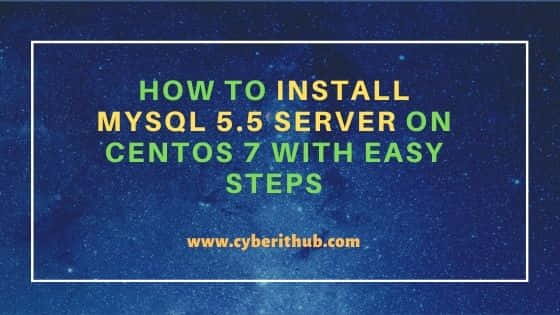

- #Centos 7 install mysql 6 update
- #Centos 7 install mysql 6 software
- #Centos 7 install mysql 6 password
If you ever need to update your MySQL server, just do it though Yum by simply upgrading the package: sudo yum update mysql-server You have now successfully set your new root account password. ): ALTER USER IDENTIFIED BY 'mypassword'
#Centos 7 install mysql 6 password
Once you have logged in, change the root password by entering the following command ( NOTE: Don’t forget to change ‘mypassword’ to the password you wish to use! Your password must be at least 8 characters long, and contain an uppercase letter, a lowercase letter, a special character, and at least one digit. Enter this next command to enter the MySQL query shell: mysql -uroot -pĮnter the password you just read from the output. Now you need to log in as the root user using this password. The output should contain the password itself. Use this next command to reveal the password: sudo grep ‘temporary password’ /var/log/mysqld.log When this is done for the first time, the root user is created with a random password, and the password can be found in the error log file. First, start your MySQL server by executing the following command: sudo systemctl start rvice You now HAVE to start the server and set the root password. Within a couple of minutes, the MySQL server will be downloaded and installed onto your CentOS 7 system. Just enter the following command to install: sudo yum install mysql-community-server
#Centos 7 install mysql 6 software
Now that we have the repository added, we can now install the official MySQL software package. Once you have successfully added the Yum repository, proceed to the next step. Enter your user account’s password when prompted to. You can use the Tab key to autocomplete the entry if you have partially typed it already. Just enter the following command: sudo rpm -Uvh

Step 2: Add the MySQL Yum repository.Īdding this new repository to your Yum program is very easy. Give it a moment to download and save the file to your machine. Navigate to a folder where you want the download to be saved, and enter the following command: wget Once you have wget, you can now download the repository file. Within the next minute, wget will be downloaded and installed onto your system. If you don’t have wget installed, simply install it by entering the following command: yum install -y wget Now, SSH or log into your CentOS 7 machine, and make sure that you have the “wget” tool installed by just typing “wget” into the bash shell. Once the page loads, right-click “No thanks, just start my download” found at the bottom half of the page, and click on “Copy Link” or “Copy Linked Address”. You then need to click on the “Download” button next to the download for Red Hat Enterprise Linux 7. To do this, go to the MySQL Yum Repository page, linked here. In order to add the new repository, we need to download it first.


 0 kommentar(er)
0 kommentar(er)
